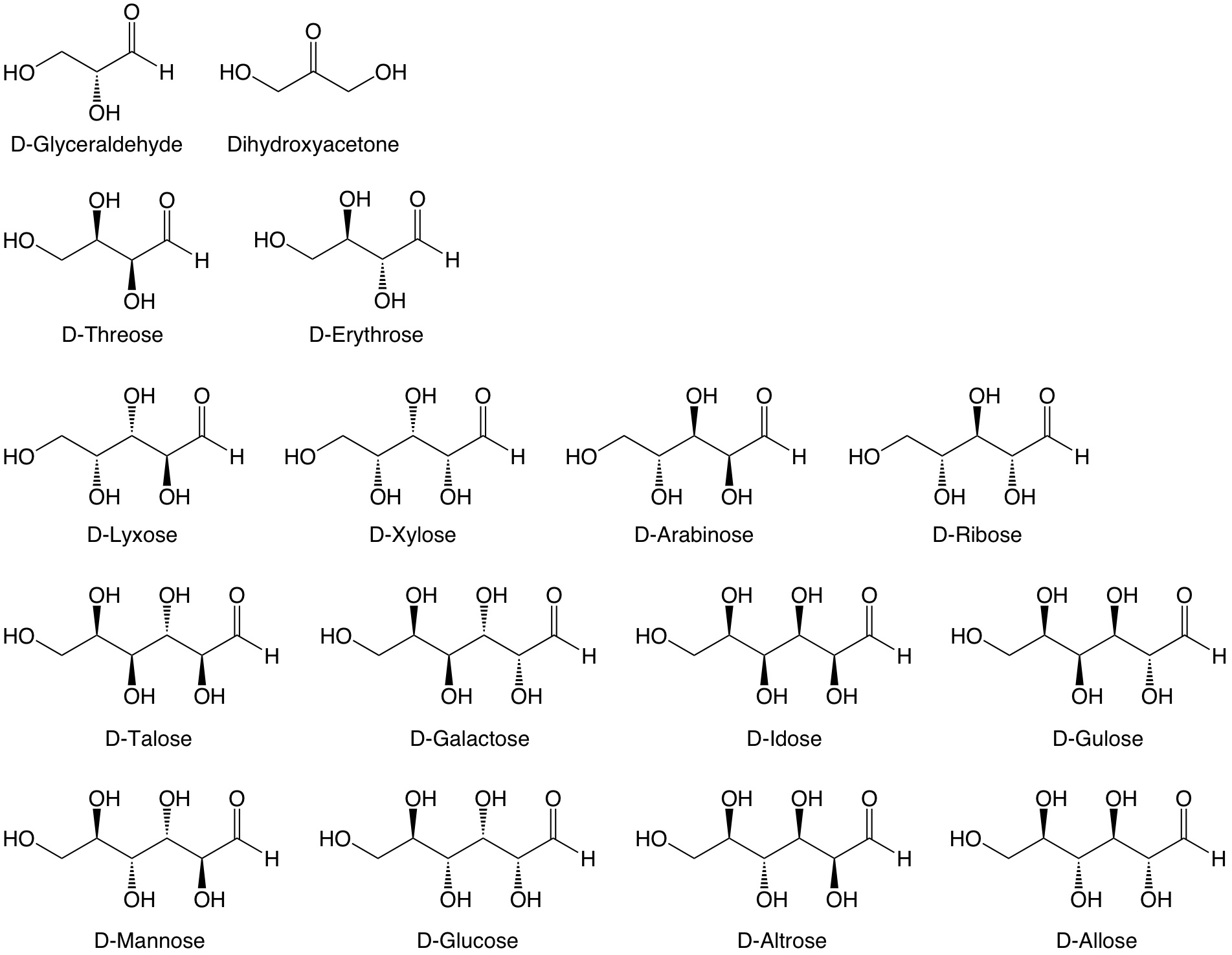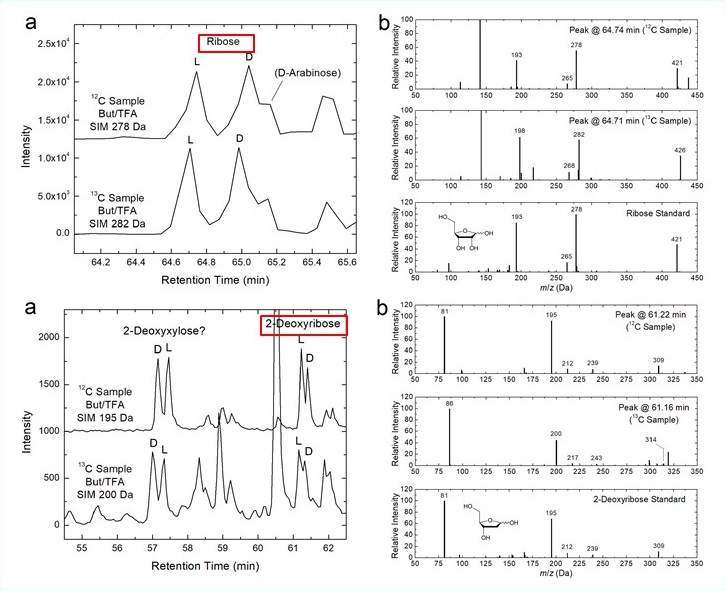What are Sugars and Sugar Derivatives?
Sugars (Figure 1) and sugar derivatives such as sugar alcohols, sugar acids, sugar diacids, and their corresponding deoxy variants (altogether sometimes referred to as ‘polyols’) are molecules that have a wide range of roles in modern biology. For example, the sugar glucose serves as the fuel source for cells, and it is also used as the building block for cellulose, the most abundant organic polymer on Earth and the main constituent of the cell walls of plants. Another important sugar used in biology is ribose, one of the building blocks of nucleotides in RNA, and of bioenergetic compounds such as adenosine 5’-triphosphate (ATP).

Figure 1:The basic molecular structures
of linear sugars (aldoses) that contain 3 to 6 carbon atoms.
Like amino acids, sugars and sugar derivatives are chiral molecules, which means that they exist in two mirror image forms, often referred to as “right-” and “left-handed”, and called enantiomers (Figure 2). Abiotic synthesis of sugars, such as the formose reaction, lead to the production of racemic proportions of sugars, i.e., equal amounts of right- and left-handed enantiomers. The situation is somewhat similar to your two hands. They have the same ‘formula’ (Palm1Fingers4Thumb1), but no amount of rotating of either hand can get the two to perfectly superpose. In keeping with your hands, these two variants of a sugar compound are often referred to as being ‘right’ and ‘left’ handed versions of the same molecule. Ribose and 2-deoxyribose, the sugars of RNA and DNA, respectively, are exclusively right-handed. This property, called ‘homochirality’, is a fundamental property of terrestrial life.

Figure 2: Like amino acids (shown here), sugar
derivatives come in right- and left-handed versions.
The Formation of Sugars and Sugar Derivatives in Interstellar Ices
Together with amino acids, amphiphiles, and nucleobases, polyols are also produced from the UV photolysis of simple astrophysical ice analogs containing H2O and CH3OH under abiotic conditions in laboratory experiments simulating cold astrophysical environments. In particular, ribose and deoxyribose, the sugar and deoxysugar that are the molecular backbones of RNA and DNA, have both been detected in residues produced from the UV photo-irradiation of simple H2O:CH3OH ices (Figure 3).

Figure 3: Detection of ribos and 2-deoxyribose,
the sugars of RNA and DNA, respectively, in an organic residue produced
from the UV irradiation of an H2O:CH3OH (2:1) ice mixture.
While sugar alcohols, sugar acids, sugar diacids, and several deoxysugar acids have been detected in abundance in carbonaceous meteorites, only a few sugars such as ribose and its isomers have recently been reported in small abundances. The total abundance of polyols in meteorites is larger than that of amino acids, indicating that significant amounts of sugar derivatives are delivered to the surface of telluric planets such as Earth.
Astrobiological Significance of the Formation of Sugar Derivatives in Space
The presence of sugar derivatives in carbonaceous meteorites and their detection in organic residues produced from the UV photolysis of astrophysically relevant ices simulating chemical processes in astrophysical environments suggest that these compounds were part of the inventory of organic compounds that were delivered to the early Earth, and possibly other telluric planets, and that could have contributed to the emergence of life. The wide range of biological functions of polyols in modern life strongly support the idea that these compounds played an important role in the first biochemical reactions leading to life.
For more detailed information on our laboratory work associated with sugars, see:
Nuevo, M., Cooper, G., & Sandford, S. A. (2018). Deoxyribose and Deoxysugar Derivatives from Photoprocessed Astrophysical Ice Analogues and Comparison to Meteorites. Nat. Commun. 9, 5276 (10 pp).
Cooper, G., Rios, A. C., & Nuevo, M. (2018). Monosaccharides and their Derivatives in Carbonaceous Meteorites: A Scenario for their Synthesis and Onset of Enantiomeric Excesses. Life 8, 36 (29 pp).
Many of these can be downloaded from our Publications page.
|